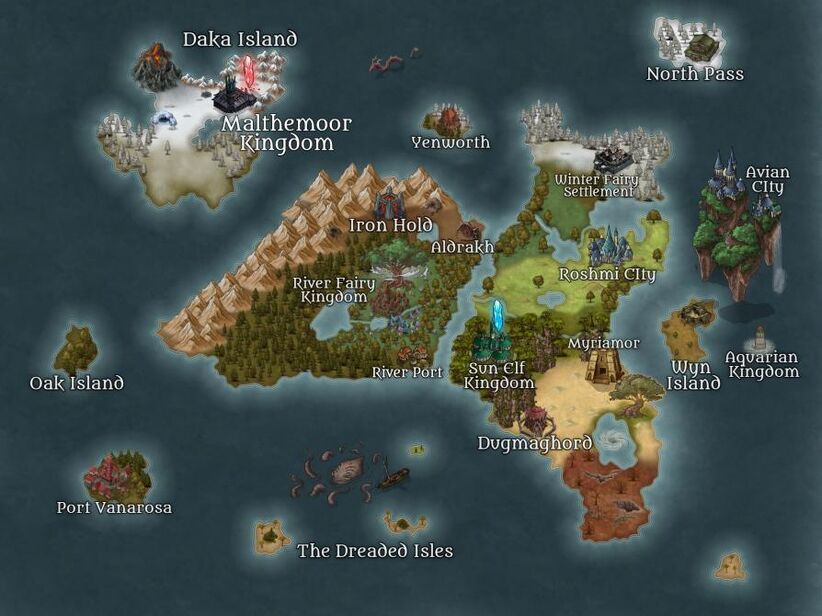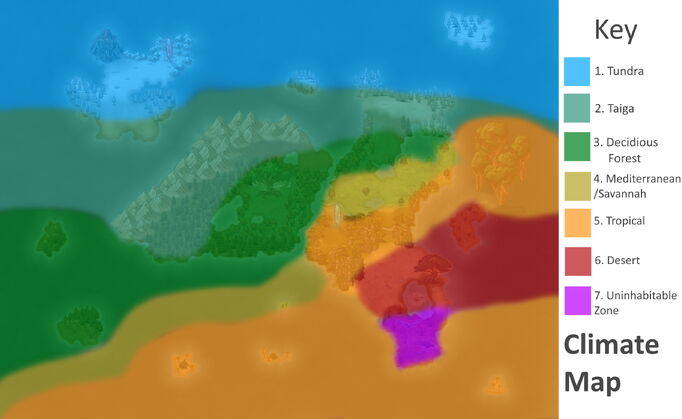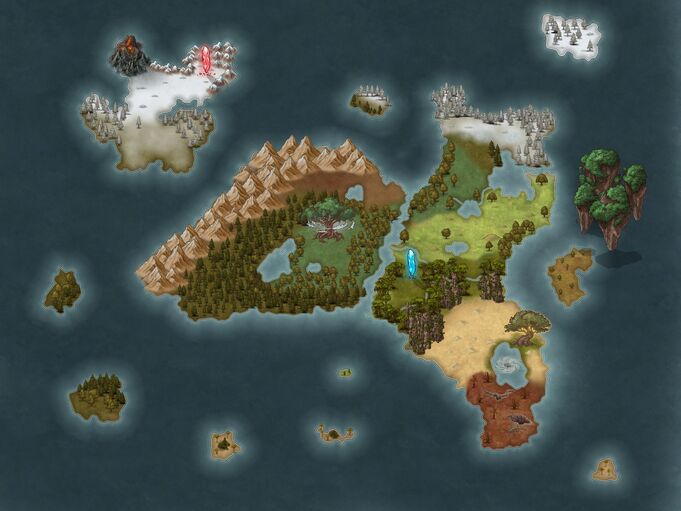About Avalia
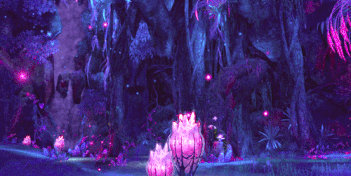
In a different dimension, on a planet called Avalia. The land did not split in the exact same as in the story you know of Pangea. It is a quite different looking world to our own. Magic flourishes in this land with the sun as its source. Their sun is very different than one in the Earthly dimension. Its pink color gives the sky a very light pink hue. Mushrooms the size of trees and trees that seem to touch the top of the sky cover the planet. Various colors beautify the forests and the lights of pixies illuminate the paths through them. Castles perched upon mountains and villages upon valleys exist as you may have imagined in fairytales. After all, those fairytale writers got their ideas from somewhere, right? If they had told everyone that, who would believe them?
There had been a time humans from Earth were very welcome in Avalia. Elves have the powerful ability to manipulate light magic, often opening up random rifts in the dimension that would suck in random humans from the other. Humans were allowed to explore and exchange knowledge from the dimensions while creatures from Avalia traveled to the other dimension to sneak peeks at Earth. Humans showed them castles, buildings, the English Language, food and anything available ranging from medieval times to the Victorian Era. Humans even brought over species of animals as gifts. However, these select humans that were allowed to dimension travel were sworn to secrecy with their lives on the line. If you had seen so many wondrous things, wouldn't you have been itching to tell someone? They were given permission to write what they had seen into stories, which others then took a liking to the themes and also incorporated into their stories. Thus, reality became a myth.
However, light elves weren't the only type of elves. A race of dark elves bred from the combination of use of powerful, dark magics and also darker thoughts. Avalians feared what these dark elves were capable of as well as their different views, and had them exiled after the Great War, which occurred about 1,200 years ago. Dark elves had been forced to live in the tundra of Daka Island since then. However, in their rage of losing the war, they assassinated all elder light elves capable of dimensional rift creation. Humans have not set foot in Avalia since that day. It was foretold by prophets that the dark elves will train and one day be able to conquer Avalia in the next war and take over new territories. Their vengeful spirit could mean slavery and misery for all of Avalia.
Because light magic and fairy magic cannot stand up enough to dark magic, a different type of magic was needed in order to avoid this. Unfortunately, humans were the only ones capable of wielding the forces of nature, magic strong enough to hold a chance against a dark elf. Their genetics in the realm of Avalia would react in such a way to make this possible. The light elves felt they had no choice but to learn to summon humans once again.
Learning to create rifts with light magic would take immense skill and experience; only the best of the best were capable.
Now, enough time has finally passed for a light elf to be old and powerful enough to create rifts once again. Powerful light elves that have lived in secrecy, training to open rifts have finally reached success at this point of time. The rifts will open and Avalia's heroes will arrive.
Avalia Magic Theory by Maihk Aech (By FunnyGuy on RoleplayerGuild)
The magic of Avalia's many races come in various forms and produce different effects. We know this, but what is the source of fuel for this. Look no further than the orbs you see in the sky. The sun is responsible for powering magic with its vibrant energies. These forms of magic include:
- Light Magic
- Chloromancy (Plant Magic)
- Healing Magic
- Pyromancy
- Aeromancy
The two moons are responsible for powering magic with the energy they reflect from the sun. The energies that were once used to power the magic affiliated with a light twist and change reflected off of the moons. This phenomenon fuels the following forms of magic:
- Dark Magic
- Cryomancy
- Demonic Magic
- Geomancy
- Hydromancy
Map
Demi-Human Settlements
Creatures in this area: cats, dogs, foxes, rodents
This city is extravagant and beautiful. It is extremely large and has a population of 1 million. Most are demi-humans but other species are allowed to reside here. It is an overflowing pot of culture and events. It is booming with fortune and wealthy citizens. Demihumans of all sorts of species can be found here.
This island has a small community of demi-humans more suited toward the cold, consisting of arctic species. It is fairly rural over here but folks are very polite and kind.
This island has more feral, less civilized demi-humans. Their speech is very basic, if any. There are no building structures.
Offshore from Wyn Island, a kingdom of mermaids can be found deep on the sea floor.
Up high east from Roshmi City, flying demi-humans choose to live up here very often to stay amongst their own.
Desert species of demi-human tend to flock to this desert city, but this is a very mixed settlement where all races can be found, much more than Roshmi City.
Daka Island
Creatures in this area: Many Dragons, Hydras, Goblins, Trolls
The dark elves reside on this island. They have made do with what they have and made their own city. It is colder up north so they often dress in heavy clothing. They are ruled by the Twin-Headed Dragon. The Daka Black Market resides here in the open as a normal shop here.
Avalian Kingdoms
Creatures in these areas: pixies, foxes, bears, wolves, reptiles, birds, many species of insects, rodents, unicorns, trolls, ogres
This is a very large kingdom that stretches out to all the homes seen on the map with markets, high-end homes and a high population of 500,000. This is mostly a magic-focused community focused on traditional values. There are woods with skyscraping trees and areas of mushrooms as large as the trees. The mushroom forest near River Kingdom is often lit up with pixies.
This is a prosperous elf kingdom is located in the Jungle of Avalia. They are very into trade and prospering careers in many sciences and engineering. They have amazing technological advancements such as the rift opener. It has a population of 600,000.
Key Trade Points
This is the northern trading point. All sorts of species come here to trade and barter. Many sailors port here to rest and eat the Yenworth Inn and Tavern.
This is a port by the Forest Canal with extensive things to do and see. Sailors and those looking for a fun night out alike will often find themselves here.
This is the southern trading spot. Pirates tend to gravitate toward this one as law enforcement is a little scarce so far from Avalia.
Orc Settlements
The Aldrakh Orc Clan is known to be quite civil but often war with not only the Dugmaghord orcs, but also the dwarves nearby. They have been tending to side with the dark elves during conflict. They are the more populated orc clan and thus tend to have better resources, architecture.
The Dugmaghord Orc Clan are known to be the more savage of the orc settlements just wanting to loot as much of anything as they can, only siding if there is profit to be gained. They are less in population meaning less shared things and more finances. They do not fear losing what they have and tend to focus on raiding and plundering to replenish anything they do lose. These orcs are not to be trusted.
Dwarf Settlements
Dwarves can be found all along the mountains, mining away, however, Ironhold is their biggest and most known settlement.
Miscellanous
This is the most dangerous part of the sea, where sea creatures of all sort have been known to terrorize sailors. Worst of all is the kraken! Much like the Bermuda Triangle in our world, many lives are lost in this area, sometimes mysteriously. Whirlpools and all sorts of dangerous events tend to happen here, making some people believe it is a magical epicenter of sorts.
This is a grassy desert area with an abandoned temple. The ruins of an ancient civilization can be found but other than that, it has been overtaken by wildlife.
This is the area on the most southern peninsula of Avalia where most life cannot survive. This is where demons come out from the abyss and tend to thrive.
Unnamed Winter Fairy Settlement -
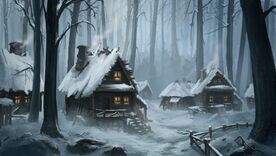
The winter fairy settlement is a very tight-knit village and there is no class system. Winter fairies look out for each other and make sure everyone is well cared for. Their population is around 5,000. They are able to flourish in the cold and have no problem with it. They have become experts in gathering food and hunting in their community. People live in around the same size homes. The law made is that the bigger the family you have, the bigger the homemade. If people need a bigger home, everyone pitches in to help them make a bigger home for their family. There is a small government of 20 fairies elected who lead the community. Dark elves were unable to locate the community and control to Aklenroth's dismay until the recent search.
Geography, Flora, Fauna, and Climate
Area 1 - Tundra
Climate
- It is very cold and dry, with a brief, chilly summer and a bitterly cold winter. Spring and fall are only short periods between winter and summer.
- Nights can last for weeks when the sun barely rises during some months in the winter and the temperature can drop as low as -94° F/-70° C. During the summer the sun shines almost 24 hours a day. Summer is usually warm but only lasts 50-60 days. Temperatures can get up to 54° F (12° C), but it can get as cold as 37° F (3° C).
- The ground is frozen up to 3 feet deep; this is called permafrost.
Winds can blow between 30 to 60 miles (48 to 97 kilometers) per hour. It is super windy near the mountainous regions. - Very little precipitation
Geography
- Dragon Spine Mountains cover the NE corner of Daka Island, the rest is mostly flat beside Daka Volcano. Coniferous forests lie here as well.
- In the brief summertime when some of the permafrost melts, it is very soggy and becomes covered with marshes, lakes, bogs, and streams that breed thousands of insects and bird species. Swampy areas in some spots.
Flora and Fauna
Plants: mostly mosses, shrubs, grasses, heaths, and lichen. Some flowers. Some birch trees.
NATIVE TO AVALIA:
- Poison bushes - the leaves on these bushes are poison to the touch as well as the berries on them called death berries)
- Glalo - black flowers with triangular petals and sharp thorns
Animals: hares, rodents, wolves, foxes, bears, wolverines, some ducks and birds.
NATIVE TO AVALIA:
- All types of dragons in large numbers. it's the only place red or white dragons can be found
- Wendigos - dwell in the frozen forests until winter before heading south.
- Wyverns
- Griffons in mountains
- Phoenixes inside or around the volcano
Area 2 - The Taiga
Climate
- Cold generally
- The summers are rainy and humid. Summer temperatures can range from a low of -7° C /20° F and a high of 21° C/ 70° F depending on how north you are. They last from 50 to 100 days. The forms the precipitation comes in are rain, snow, and dew. Most of the precipitation in the taiga falls as rain in the summer.
- The spring and autumn are barely existent.
- Low rate of precipitation (snow and rain), and short growing season. Winter fairies tend to have an influence on the snow rate though. Snowstorms and blizzards can occur. Winters last up to 6 months, with average temperatures below freezing with temperatures ranging from -54 to -1° C (-65 to 30° F) in the northern areas.
Geography
- Bluehorn mountains are located near the northern coast.
- Plants: lichens, mosses, shrubs, foxglove, grasses, heaths, flowers, belladonna, raspberry, blackberry, and cranberry bushes, in lower regions apple trees and orange trees coniferous trees(pine, white spruce, hemlock), as well as blueberry bushes.
Flora and Fauna
Plants: mostly mosses, shrubs, grasses, heaths, and lichen. Some flowers. Some birch trees.
NATIVE TO AVALIA:
- Poison bushes
- Glalo
- Alaberry bushes - very sweet and tangy pink berries)
- Tunto trees - VERY tall trees with thick orange trunks
- Riverfruit Trees - these trees grow exclusively near rivers and have the sour yet sweet large purple-colored fruits
- Snowberries - white berries that only grow in the winter
- Curling Trees - branches on these trees curl in bizarre ways and are absurdly long
- Habakuus - a giant carnivorous plant that will open up causing unsuspecting travelers to fall inside and digest them in its acid.
Animals: lynx, wolverines, bobcat, rabbits, red squirrels, red deer, elk, moose in lower areas, bears, foxes, wolves, hares
NATIVE TO AVALIA:
- Griffons in mountains,
- Goblins in swarms
- Ogres,
- Trolls,
- Wyverns,
- Beastmen,
- Hydras,
- Around 5 black dragons dwell in the swampy caves in the area.
Area 3 - Deciduous Forest
Climate
- These areas are that of deciduous forest with a temperate climate. There are four distinct seasons: spring, summer, autumn, and winter
- Precipitation is a lot higher. It is more humid where storms can occur.
- Winters are not as brutal but can get pretty cold.
Geography
- Rivers and lakes, mostly flat deciduous forests
Flora and Fauna
Plants: oak, beech, maple, elm, and walnut trees, foxglove, azaleas, mountain laurel, huckleberries, mosses, many herbal plants, grapes, apples, pears, peaches, plums, cucumbers, nectarines, cherries, apricots, avocados, blueberries, raspberries, elderberries, blackberries, and kiwis
NATIVE TO AVALIA:
- Fleefa Trees - bear Fleefa fruits which are large, blue, and very sweet. They weigh up to 20 pounds because they are so big. The trees are very big as well as the branches in order to be able to hold up such weights as you can imagine
- Alaberry bushes - very sweet and tangy pink berries
- Tunto trees - VERY tall trees with thick orange trunks
- Riverfruit Trees - these trees grow exclusively near rivers and have the sour yet sweet large purple-colored fruits
- Mushroom trees - these are not really trees but the mushrooms are as big as trees and there are actual mushroom forests so they are referred to as such
- Thornflock - a medium-size tree with large thorns that bears small very poisonous spiny berries. One berry is potent enough to kill 100 people.
- Habakuus - a giant carnivorous plant that will open up causing unsuspecting travelers to fall inside and digest them in its acid.
Animals: foxes, ducks, bears, deer, squirrels, bunnies, wolves, reptiles, birds, many species of insects, rodents, boars, chickens, cows, pigs, goats, deer, sheep
NATIVE TO AVALIA:
- Pixies
- Unicorns
- Pegasus
- Goblins in swarms
- Ogres
- Trolls
- Wyverns
- Beastmen
- Hydras
- Owlbears
- Around 5 green dragons dwell in the forest caves around the lower parts of the mountains in the area.
Area 4 - Meditarrenean
Climate
- It is quite hot and a bit on the drier side here. It rains but not super often. All 4 seasons.
- Winter is very mild and is usually about 10°C/50°C lowest. Summer is very hot at 40 °C/104°F highest.
- Wildfire problems at times
Geography
- Rivers and lakes
- Plains, spread out leafy trees
Flora and Fauna
Plants: poison oak, oak trees, yucca, shrubs, cacti, palm trees, hawthorn, mahogany, sycamore tree, alder tree, pine trees, lavenders, poppies, roses, grapes, almonds, strawberries, oranges, walnuts, dates, figs, kiwi fruit, nectarines, olives, pistachios, prunes, avocados, grapes, lemons, melons, peaches, cucumbers, plums, sycamore, cottonwood, ash, eucalyptus, watermelon, berries, oranges, cocoa, coffee beans, and strawberries.
NATIVE TO AVALIA:
- Fleefa Trees - bear Fleefa fruits which are large, blue, and very sweet. They weigh up to 20 pounds because they are so big. The trees are very big as well as the branches in order to be able to hold up such weights as you can imagine
- Alaberry bushes - very sweet and tangy pink berries
- Tunto trees - VERY tall trees with thick orange trunks
- Riverfruit Trees - these trees grow exclusively near rivers and have the sour yet sweet large purple-colored fruits
- Mushroom trees - these are not really trees but the mushrooms are as big as trees and there are actual mushroom forests so they are referred to as such
- Thornflock - a medium-size tree with large thorns that bears small very poisonous spiny berries. One berry is potent enough to kill 100 people.
- Habakuus - a giant carnivorous plant that will open up causing unsuspecting travelers to fall inside and digest them in its acid.
- Talamaki - Giant venus fly traps about five feet tall
- Chima nuts - very salty peanut-like nuts
- Mami trees - Pink trunk trees with very soft leaves
Animals: coyotes, rabbits, deer, alligators, bears, owlbears, lizards, cougars, foxes, squirrels, chipmunks, rodents, chickens, cows, pigs, goats, deer, sheep
NATIVE TO AVALIA:
- Pixies
- Unicorns
- Owlbears
- Goblins
- Ogres
- Trolls
- Pegasus
- Wyverns
- Beastmen
- Hydras
Area 5 - Tropical Jungle
Area 6 - The Desert
Climate
- Hot and dry; this is a desert
- Not much of a winter
- Blazing hot days; cooler nights
- Spring and Autumn are not much of a thing here. It just mostly always summer with a very brief winter. Opposite of 1
Geography
- Flat, dry, sandy, what you would expect from a desert...
- Water is lacking
Flora and Fauna
Plants: shrubs, short woody trees, turpentine bushes, prickly pears, brittlebush, cacti
NATIVE TO AVALIA:
- Cactus Trees - 50 foot high cactuses
- Sand berries - bushes that grow red berries that taste like cinnamon
- Gowa berries - salty berries
- Qam fruit - brown, long fruits that grow on rare desert plants that make sweet things taste salty and sour things taste sweet; expensive since only in the desert
- Nawa cacti - Neon pink cactuses
Animals: desert foxes, lizards, camel, scorpion, tarantulas, antelope, snakes
NATIVE TO AVALIA:
- Wyverns
- Hydras
- Sphinxes
- Near the oasis of the Orcs are goblins and ogres
- Around 5 blue dragons stay in the harsh desert, dwelling inside various caves.
Area 7 - The Uninhabitable Zone
